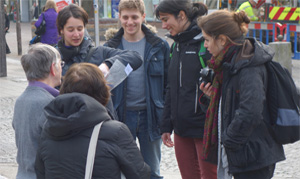www.thelandofthesummerpeople.org
Ludovica Beltrame – Engineering PhD candidate with the Water Informatics: Science and Engineering (WISE) CDT
The Somerset Levels and Moors are a low lying region prone to frequent flooding due to a range of environmental and human factors. The history of drainage and flooding in the Levels is rich and unique, yet its present condition is unstable and its future uncertain. Winter 2013-14 for example saw extensive floods in the Levels that attracted significant media attention and triggered debate on how such events can be mitigated in the future. The Land of the Summer People Science & Art project brings together engineering PhD students with local artists to increase public awareness and understanding of the Somerset floods. Scientific understanding and traditional engineering tools are combined with the artists’ creativity to prompt discussions about the area’s relationship with floods in a medium designed to be accessible and enjoyable.
Working at this project was an unprecedented experience. Not only it was a chance to explain something that we do to a wider public, but also an opportunity to learn something ourselves that we do not usually learn from data and numerical analyses.
The topic my group chose to focus on is the future of flooding in the Somerset Levels and Moors. The starting point was our scientific knowledge about the topography of the area, the current action plan, and climate and land use change potentially impacting flooding in the future. From here, guided by the artist we were working with, we went through a process thinking about how we could convey this information. How do we communicate to the future? How do we communicate to the present to shape the future? There was the need of some research and experimentation, but in a new different way compared to what we are used to. This time it was all about thinking about how to engage with the public, what techniques to use, what materials to employ.
We came up with the idea of making a flood survival kit, containing several items bringing together ideas about causes and impacts of flooding in the area, as well as symbolic tools for adapting to floods. The plan was to give our kits to people walking on the street and start conversations about flooding, aiming at raising awareness on the topic and stimulating interest and responses. The performance took place in Taunton on March 17th. At first, it was exciting and scary at the same time: howto approach people? Will they be keen on talking with us? What will they expect? What will they tell us? However, very soon we felt much more comfortable and giving our kits not only provided us with the chance to talk about our project, but also opened the opportunity for establishing deeper connections with people, sharing stories and memories. Studying the physical processes of floods or the topography of the area does not make you aware of the experience of flooding and the effects the local communities have to cope with. Most of the people we met and talked to had actually experienced flooding or knew someone who had experienced it and it was interesting engaging and listening to their stories.
For us engineers, finding an alternative way to talk about flooding was challenging. However, using art to communicate with people turned out to be a nice way of generating interesting discussions and adopting a different perspective helped us understanding aspects of what we study and work on that data cannot teach us.


